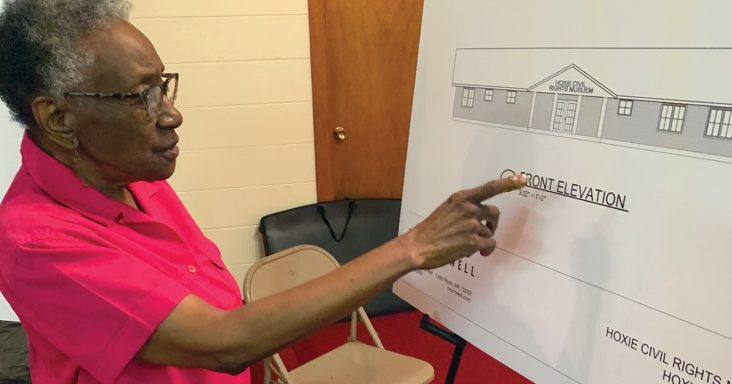Supporters ramping up efforts for Hoxie Civil Rights museum
by October 7, 2021 7:38 am 1,061 views

Ethel Tompkins, the driving force for a Hoxie Civil Rights Museum.
Ethel Tompkins was at the 60th anniversary celebration of the Hoxie School District integration when she was asked a simple, but poignant question. She was one of the Black students who in 1955 integrated the Hoxie School District, one of the first districts in the South to do so, and it was done in relative peace compared to other integration efforts that would follow.
The historic moment for Northeast Arkansas is often forgotten. She helped to form Hoxie: The First Stand, a nonprofit group that hopes to build a Civil Rights museum in Hoxie.
“It came about as an off-hand suggestion … Someone asked, ‘Why don’t we have a museum?’ I thought to myself that’s a good question. What we did in Hoxie … somehow it got lost.”
Back in 1955, the school district had financial problems. Superintendent Edward Kunkel Vance hatched a plan. He decided to integrate the student body. At the time, he said he supported it because it saved the district money, it complied with the recently decided U.S. Supreme Court case Brown vs. The Board of Education of Topeka, Kan., and it was “right in the eyes of God.”
In July of that year, 29 Black students entered the previously all-white school. Only 21 would complete the term, Tompkins said. An avid reader, Tompkins said she marveled at how many books were in the school library and how much nicer the facilities were.
“It was quite a transition. My dad always told me to walk into a room and act like you own it. That’s what I did,” she said.
Weeks after the first school bell rang that summer, more than 350 segregationists met at the Hoxie City Hall to call for a boycott of the school. The five school board members who voted to integrate were asked to resign, and then Gov. Orval Faubus said he would not provide any additional state resources to help with the integration. Emotions ran high according to many public reports at the time, but no major violence erupted even as outside segregationist groups descended on the small town.
The National Association for the Advancement of Colored People (NAACP) sent a woman to study how the integration unfolded. She was sent at the behest of a young attorney, Thurgood Marshall, who would later become the first African-American to sit on the U.S. Supreme Court. He sent each family in the Black community a letter cautioning them to keep the transition as peaceful as possible.
Life Magazine chronicled the Hoxie integration, and it was hailed as a remarkable success. There were still bitter consequences for the students, their families, and even some of the white administrators who chose to combine the student body, Fayth Hill Washington previously told Talk Business & Politics.
Hill was in the fourth grade at the time of the integration. Washington remembers the Hoxie Colored School, the one they used before integration, far too well. It housed grades 1-8 in the one-room school. A “pot-bellied” stove kept the drafty building warm, she said. When it rained, the surrounding yard would flood. Students had to use the leftover or replaced books from the white school. Many books didn’t even have covers. High school students had to be bused to Jonesboro.
Tompkins remembered each day students had to go to a neighbor’s house to fill a water bucket in the morning and in the afternoon. It had one ladle or dipper that all the students had to share, she said.
Students sneered, laughed and made jokes about her once the schools combined, Washington said. Children in the community who knew her and played with her before the integration shunned her. A teacher read the book “Little Black Sambo” and the class erupted in laughter while looking at her. The “N” word was uttered at will, and her older brother wasn’t allowed to play sports because other schools hadn’t integrated yet.
“We were integrated, but we were still segregated. … It wasn’t fun at all,” she said. “Kids can be very cruel.”
Eventually, the segregationists took their case to court. Washington’s father, Marshall, testified during the case. He was the only Black person to testify, and it cost him dearly, she said. He lost his job and he eventually had to move to Gary, Ind. to find work. Integration did ultimately prevail in court, and the decision was a hallmark in Arkansas used by school districts for decades to integrate their schools.
It will cost about $500,000 to build the proposed museum, Tompkins said. The former Masonic Lodge in Hoxie will serve as the physical structure for the museum. Efforts to raise money began to ramp up in late 2019, but were stalled when the COVID-19 pandemic struck in March 2020.
The organization will attempt to host a series of fundraisers and will seek grants. It’s been difficult to plan a fundraising campaign due to the surge in COVID cases.
Once they have the funding, a series of displays will be constructed in the museum. One exhibit will feature a replica of the Hoxie Colored School. Artifacts will be displayed along with storyboards that will explain the plight of the first Black students in the combined Hoxie School District. Classes for local school districts will also be held.
Tompkins is hopeful a museum in Hoxie will be part of a burgeoning Civil Rights history tourism trade in the region that could be fueled by efforts to build a similar museum at the former Colored School in Newport and the already established Eddie Mae Herron Center in Pocahontas.
“We want to celebrate our history,” she said.
